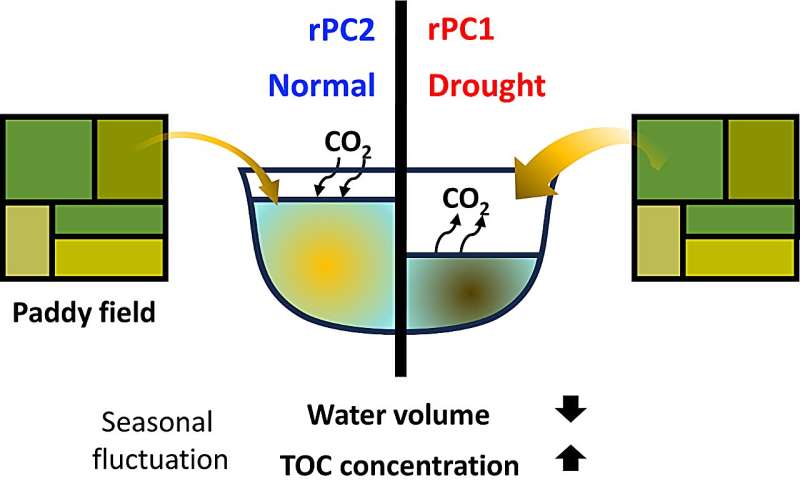This article has been reviewed according to Science X's editorial process and policies. Editors have highlighted the following attributes while ensuring the content's credibility:
fact-checked
peer-reviewed publication
trusted source
proofread
Unraveling the drought dilemma in South Korea: Can reservoirs be a carbon source?

Researchers analyzed water quantity and quality data from domestic agricultural reservoirs to shed light on the hydrological impacts of a severe drought on degrading the water quality.
Professor Jonghun Kam and Kwang-Hun Lee, a Ph.D. student, from the Division of Environmental Science and Engineering at Pohang University of Science and Technology (POSTECH) research findings were recently published in Water Research.
The recent climate crisis has resulted in more frequent extreme weather events, such as droughts and floods. Although models have outlined the anticipated effects of these extreme events on the global water cycle and carbon cycle, efforts to quantitatively comprehend them using observational data have been limited by the limited available big data on water quantity and quality.
During spring, the onset of rice planting necessitates ample water in rice paddies and fields in South Korea. Since precipitation is not consistent from year to year and from season to season, over 3,000 agricultural reservoirs across the country have been employed for water resource management.
Water level data from agricultural reservoirs has monitored the amount of water available during the crop planting season with additional collection of seasonal water quality data from the reservoirs since 2020. This national-level dataset from the reservoirs offers a unique opportunity to investigate coupled dynamics of the water and carbon cycle.
In their study, researchers utilized rotated principal component analysis to extract key major modes of the extensive datasets of water levels and water quality that encompasses information on water volumes and total organic carbon (TOC) concentrations from over 2,200 agricultural reservoirs in Korea spanning from 2020 to 2022.
During the study period, reservoir volumes ranged from 289 to 360 metric tons (106t), TOC concentrations varied between 3.54 and 4.60 mg/L, and TOC loads ranged from 1,165 to 1,492 tons.
The first major mode of the rotated principal component analysis unveiled a notable trend: as water temperatures rose and reservoir levels dwindled due to drought in the southern region of the Korean Peninsula in 2022, there was a corresponding increase in TOC concentrations. In the second major mode, the researchers observed a significant correlation between fluctuations in reservoir levels in the central area and shifts in TOC concentrations.
Moreover, the research found that elevated TOC concentrations were observed in a region where a larger areal fraction of rice paddy fields surrounding agricultural reservoirs. These findings underscore the potential shift of the role of agricultural reservoirs from carbon storage to carbon source that emits carbon into the atmosphere during the period of a severe drought.
Professor Kam stated, "By leveraging water big data and advanced statistical methodologies, we've quantitatively demonstrated alterations in the water and carbon cycles triggered by extreme drought."
"This underscores the pressing need to develop integrative environmental and water policies to prioritize both quantity and quality, especially as we transition into a carbon-neutral era."
More information: Kwang-Hun Lee et al, Spatiotemporal patterns of water volume and total organic carbon concentration of agricultural reservoirs over South Korea, Water Research (2024). DOI: 10.1016/j.watres.2024.121610
Journal information: Water Research
Provided by Pohang University of Science and Technology




















